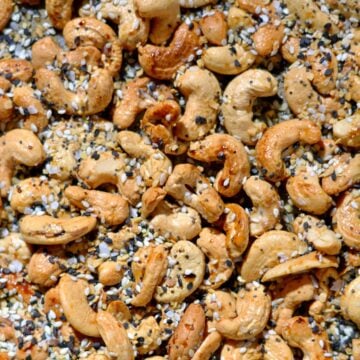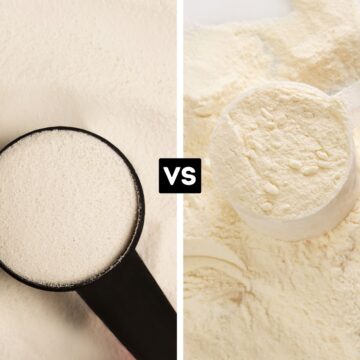With the rise of plant based diets, plant based milks are also on the rise. Due to its sustainably and creamy texture, oat milk is arguably one of the most popular dairy free milks on the market. While it is typically readily available, there may be times when you cannot find it or need to substitute it for other reasons. If that’s you, then read on! We will go over all the basics of oat milk, how to successfully substitute in recipes that call for oat milk, and how to use oat milk as a substitute for cow’s milk.

Want to save this recipe?
Enter your email below & we'll send it straight to your inbox. Plus you'll get fun new recipes from us every week!
So you want to use plant based alternative milks? What a great decision! Plant based milk has come so far and can be used in place of regular milk in nearly any recipe, food, baked goods, coffee, and so many other things. Obviously, plant milk and cow’s milk are very different in make-up so some caution should be used with replacing one for the other. Because you came here for oat milk, that’s what we will focus on!
An Overview of Oat Milk
What is oat milk?
Oat milk, in its simplest form, is oats and water blended and strained. It is free of nuts, soy, and lactose and is one of the most sustainable plant milks out there. Some oat milks include additives such as sweeteners and thickeners.
How does oat milk compare to cow’s milk and is it sustainable?
Because oat milk is made from oats and cow’s milk is not, they vary in nutritional value and taste. Cow’s milk is made up of 87% water while oat milk is roughly 80% water. Cow’s milk is also higher in fat with 8g per serving and oat milk at 1.5g per serving. Because the fat content of oat milk is so much lower than cow’s milk, manufacturers often add thickeners to oat milk so it better resembles cow’s milk.
While healthier for you, most recipes rely on that higher fat content. When substituting oat milk for cow’s milk, you should add additional fat via other ingredients to make up for the lack of natural fat. This could be with nut butter, coconut oil, or vegetable oil. Some other nutritional differences are fiber content, protein, and total sugar. All of these differences have been summarized below for quick reference.
As far as sustainability, oat milk is one of the better options. Many plant-based milks have gotten slack due to their environmental impact, but they are still a better choice than cow’s milk from an environmental perspective. Almond milk requires 23 gallons of water per 8 ounce serving and cow’s milk takes 2.5x that. Oat milk requires about ⅙th of the water that almond milk does.
It should be noted that plant-based milks are manufactured in VARY different ways (even between milks of the same type - almond, oat, soy). Because of this difference, it is incredibly hard to precisely track the full environmental impact of the plant milk industry. Check out this great article for a full explanation of the environmental impact of milks.

What do you look for in a good oat milk?
Obviously, if you are on this page, you probably believe either A. oat milk is the best and you want to use it in everyday recipes or B. oat milk is not the best and you need another option. Either way, there are some key things to look for in a good oat milk that are also things to be aware of when picking any type of milk.
Sweet or not sweet: This is the first thing to look at. Is it sweetened or unsweetened milk? Unsweetened is better for your health but added sugar can make it more palatable if you are not used to oat milk. If you are switching from cow's milk to oat milk or substituting it in a recipe, it is better to buy sweetened oat milk and drink it than buy unsweetened and not drink it or end up switching back to cow’s milk. I’ve heard people describe plant-based eating as a spectrum; some is better than none. And that holds very true for plant-based milks.
Ingredients: As mentioned above, many will have thickening agents. This is more common in oat creamers or “barista” blends, as those are trying to replace whole milk or half and half (highest fat content and creamiest). These may have things like sunflower oil to thicken and gellan gum to keep the plant milk ingredients from separating.
Gellan gum is a controversial ingredient because one animal study linked high doses of gellan gum to abnormalities in gut lining. It is similar to gelatine or agar in that it is a stabilizing ingredient that is derived from pond plants. Because it is traditionally harvested, scientists developed a way to produce it via fermentation for a more sustainable way to acquire it. Despite some people's hesitation to it, I have found that the addition of gellan gu, makes for one heck of a good creamer. Plus, the number of studies that have found no adverse effects far outnumbers the one study that did and the same cannot be said for studies about the adverse effects of added sugar.
Environmental Score (of the brand): Regardless of why you are eating or drinking dairy-free or plant-based, you should always consider the environmental impact of your consumption. Retailers and apps have made this simpler over the years with labeling or scanning technologies. Check out the list of resources below! As far as oat milks go, below I have listed commonly found brands that also pass the sustainability test.
Sustainability Apps: Co-Go, Good On You, Happy Cow, Sustainable Palm Oil Shopping, Good Guide (source)
Oat Milk Brands: Planet Oat, Silk’s Oat Yeah, Elmhurst 1925, Califia Farms, Thrive Market Oat Milk, Trader Joe's Oat Milk, Oatly, or want to make your own? Try this recipe!
Accessibility: Plant milks are typically more expensive than cow’s milk and can be harder to find. Oat milk is typically the most expensive, coming in at roughly 2.5 times the price of cow’s milk. This higher price tag is due to the manufacturing techniques and time-intensive processing.
Another issue is that rural areas will often only stock 1 or 2 types of non-dairy milk (if any) and what they do stock might be the sweetened version. Oat milks also have a very short shelf life once opened, which I’ll talk about later. This makes it difficult to buy if you aren't sure you will drink a larger size container. Ways to get around both of these are to buy smaller sizes of shelf-stable oat milk in bulk at places like Costco or Thrive Market. While both of these stores require subscriptions to purchase from them, the savings in not only oat milk but other bulk products, usually pays for itself very quickly. Check out the comparison of similar oat milks below.
Costco Oat Milk:
- Made with sunflower oil and other additives
- Shelf-stable until opened
- $0.06 per ounce
Oatly Oat Milk:
- Made with rapeseed oil and other additives
- Shelf-stable option until opened
- $0.17 per ounce for shelf-stable option / $0.06 for refrigerated option
Thrive Market Oat Milk
- Made of water and oats
- Shelf-stable until opened
- $0.11 per ounce
Elmhurst 1925
- Made of water and oats
- Shelf-stable until opened
- $0.17 per ounce
Oat Milk Questions and Answers
How long does oat milk last?
A shelf-stable sealed container of store-bought oat milk (found in the pantry aisles) should last for many months after purchasing (just check the expiration date). Oat milks found in the refrigerated section should be kept refrigerated but can be left at room temp for up to a couple of hours without issue. Many brands of oat milk list that their oat milk should be consumed within 7-10 days of opening. In our experience, we’ve consumed oat milk up to 2 weeks after opening with no issues so use your best judgment. If it starts to smell bad, toss it out!
Is oat milk gluten-free?
Oats are naturally gluten-free. However, oats are often grown and processed with plants that contain gluten, and can therefore be contaminated with gluten (source). Therefore, oat milk can also be contaminated with gluten.
If you have gluten sensitivity, you should check the label of the oat milk you purchase to see if it’s certified gluten-free. Oatley is a certified gluten-free oat milk brand that we love!
You can also make homemade oat milk using certified gluten-free oats. Check out this recipe!
Can you froth oat milk?
Oat milk is great to froth and is often the milk of choice for baristas! In a comparison of frothability (yes, it’s a word) of different plant milks, oat milk was the most similar to cow’s milk. Oat milk that does not have any additives typically froths more because of its low fat and protein content. The lower fat means the contents are lighter and the lower protein means it will take longer to heat oat milk than cow’s milk. Oat milks with added gums will typically not froth because they are too heavy, but they sure will be creamy! If using the oat milk for latte art, it may take trial and error to get the microfoam required for latte art. Check out this post for tips on how to get microfoam with plant milks!
Can you freeze oat milk?
Many oat milk containers say “Do not freeze”. This is because when oat milk is frozen, the solids and liquids separate due to different freezing points. Once thawed, the solids and liquids do not remix unless they are blended again which I am guessing most of the population is unlikely to do. Although it might look strange, the milk will still be fine to drink! There are situations where freezing it is beneficial. If you enjoy iced coffee or smoothies, using frozen oat milk is a great way to keep the drink cold without it becoming diluted as the ice melts. To make oat milk ice cubes, simply pour the milk into ice trays and freeze just as you would water.
Oat Milk Substitutes
Many things can be an oat milk substitute but the type of recipe will determine the best substitute for the oat milk. Some milks will separate when they come into contact with acid because the acid causes the pH level in the milk to drop quickly and the milk protein to then attract each other thus forming clumps and appearing curdled. While the milk is not actually curdled, it doesn't look pleasant and the clumps result in a usual texture.
A trick for vegan baking is actually to mix an acid and a plant-based milk to encourage this “curdling” and mimic buttermilk. Unfortunately, for most recipes, you want to avoid having the milk clump. To help avoid this, we will separate substitutes by those that can be mixed with an acid and those that cannot. You can also avoid curdling by adding the milk ingredients to a dish first and then the acid or by making a slurry with the milk and thickener (if there is one) prior to adding it to the acid-based mixture.
All of these substitutes are a 1:1 substitute unless otherwise noted.
Can Be Mixed With an Acid (coffee, tomato sauce, vinegar, etc)
Flax Milk:
Flax milk is thick and creamy. It makes for a great substitute for oat milk in coffee or other drinks. Because of just how thick it is, however, it can take some getting used to and can often benefit from some ice melting into it. It is not ideal for use in cereal or drinking on its own because its texture resembles more of a slurry rather than a liquid. Flax milk does have a slightly sweet taste (even the unsweetened) so it can take some getting used to.
Cashew Milk:
Cashew milk is similar to flax milk. It is also thick and creamy and great in coffee. These types of milk offer the thick texture of half and half without the addition of vegetable oils or other thickeners that some plant-based creamers have. Cashew is one of the most neutral flavors making it extra great for drinks.
Coconut Milk:
Coconut milk is common in curries and other hot foods and drinks. This is by no accident as it does very well when combined with an acid. Coconut milk has a high-fat content and less fibrous solids that could separate. Coconut milk comes in a wide variety of textures. For soups and creamers, we recommend using coconut milk from a can. Use the cream at the top of the can and reserve the liquid at the bottom for smoothies. For smoothies, cereal, or baked goods, you can use coconut from a box (found next to dairy milk or in the cereal aisle).
Should Not be Mixed with an Acid
Almond Milk:
Almond milk is the most common plant-based milk on the market but it separates easily when coming in contact with acids. It is great for making vegan buttermilk, however! Simply add 1 tablespoon of lemon juice or vinegar to 1 cup of almond milk and let it sit for 5 minutes to curdle into vegan buttermilk!
Hemp Milk:
Hemp milk is a great substitute for cereal as it is very light with a mild flavor. It can typically be found in a shelf-stable box next to the cereal. This makes it very good milk to keep in the pantry. Due to its light texture, it does not make for a good creamer or thickener.
Rice Milk:
Rice milk is similar to hemp milk in that it is thin with a mild flavor. Rice milk is my milk of choice when substituting in baked goods because it has a similar water content to skim milk. It is also typically found in a shelf-stable container next to the cereal.
Conclusion
We hope you learned a thing or two about oat milk! And if you were looking for a substitute, we hope you found one that works for you!






drop us a note!